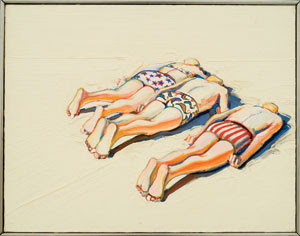
The Pasadena Museum of California Art (PMCA) is currently home to over one hundred and twenty drawings, etchings, prints, and paintings from the talented hand of Wayne Thiebaud, the now 88-year-old artist. Arriving at the October 9th PMCA benefit dinner and members opening in a lavender colored button down and a heavy pair of glasses weighing on his nose, Thiebaud, when asked to describe the intentions of his art, unabashedly stated with a slight smile, “It doesn’t really mean anything.”
Thiebaud’s humorous response appropriately defines his rather multidimensional style of painting, alongside other Northern California Funk artists such as William T. Wiley, Roy de Forest, and Manuel Neri (many of whom taught with Thiebaud at UC Davis’ fine arts department), which frequently links high art with pop culture in a sarcastic, bold, and interesting way that starkly contrasts the Abstract Expressionism work emerging contemporaneously from the New York school. Known best for his paintings of candy apples, cakes, and other confections, PMCA’s Thiebaud exhibition also highlights the artist’s less familiar paintings of brightly colored, semi-abstract California landscapes and unique renderings of the traditional subject of the human figure.
Upon entering PMCA’s main gallery, an explosion of vivid colors splashed on canvas hits the eye of the viewer. The obvious initial works to view, as noted by the hoards of museum members who crowd the gallery wall, mouths slightly salivating, are Thiebaud’s dessert paintings. In Cake Window (1976), Thiebaud paints a variety of cakes placed delicately on high stands, their shadows looming below on the stark, white display case. The cakes are rendered in rich pastels, allowing the frosting and decorations to glisten and seemingly drip from their realistic shapes into the viewer’s mouth. However, while clearly images of sugary treats, Thiebaud makes no attempts to hide his graceful, painterly brush strokes, as his hand is easily identified in the layers of while paint surrounding the cakes.



Of unusual significance for the viewer of Thiebaud’s work are his canvases laden with most traditional, and thus, frequently dull subject, the human figure. Thiebaud’s painting bodies, however, fail to disappoint and are instead treated to the same pastels, layers of paint, and broad strokes as his dessert images. In Three Prone Figures (1961), Thiebaud depicts three beach-goers lying on their backs, faces down in the sand. Their pale bodies float side by side in the middle of the canvas, surrounded by a sea of white paint. Far from a fun day at the beach, the isolation of the three figures from each other as well as to their surroundings suggest a longing and distance between the bodies, as a supposedly happy memory appears tinged with a disturbing loneliness. It is worth noting that, while viewing Three Prone Figures, I heard a couple remark that the stiff corpses were more appropriate for body bags than a day in the sun. As Thiebaud remarked in the Palm Springs Museum Art Museum, “The isolated figure series… are not supposed to reveal anything. It’s like seeing a stranger in the some place like an airline terminal for the first time. You look at him, but you don’t have any particular feeling about him.” Thiebaud’s treatment of the figure, much like his desserts and landscapes, are familiar images displaced into the realm of the slightly fantastical and strange, providing the viewer with a different and far more interesting perspective with which to observe quite ordinary subjects.


No comments:
Post a Comment